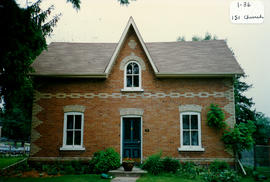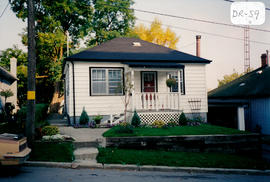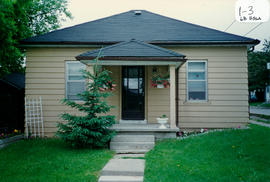151 Church Street - The Gummerson House
- CA BWGPL GJ-HB-2017-03-18-12
- Unidad documental simple
- 1996
Parte deGeorge Jackson fonds
The Gummerson House is located at 151 Church St. (on the southeast corner of Church and Queen Streets). It was built in the Gothic Revival Cottage style around the 1880’s. The Gummerson family moved to Bradford from Bond Head (on the southwest corner of Beeton Road) in 1886. This structure later became the home of Rose MacEwan. Sue and Philip Richards also lived here at one time.
The 1½-storey, three-bay ‘cottage’ has a one-storey and a 1½-storey rear additions. There was a barn at the rear originally. The house has a centre hall plan and a medium-pitched, gable roof with steeply-pitched dormers. It has dichromatic brickwork at the stylised quoins and a patterned belt course. There is an accent brick, diamond pattern at the dormer and gable peaks and at the curved, brick lintels at the openings. There are large window openings with high floor to ceiling heights. The house has four-pane, casement windows at the front and 2/2 wood, sash windows at the sides. Painted, wood, lug sills remain. The front dormer has a round-headed casement. Original windows and doors, loadbearing, brick masonry construction, and a stone foundation also remain. An inscription in a brick at the rear of the building reads: “Sept. 3, 1886 prayer meeting”. According to the 2000 inventory, the lack of Gothic Revival features (such as a porch and gingerbread trim) indicates a more modest, vernacular variation. It also notes that the house originally had three chimneys (one at each of the gable ends) and a barn at the rear. (1, 3)
Sin título










